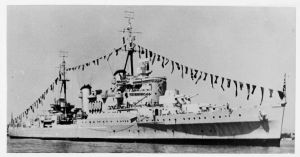HMS Newcastle (C76)
|
|

| |
| Career | 
|
|---|---|
| Ordered: | |
| Laid Down: | 4 October 1934 |
| Launched: | 23 January 1936 |
| Commissioned: | 5 March 1937 |
| Decommissioned: | 1958 |
| Fate: | Sold for scrap August 1959 |
| General Characteristics | |
| Displacement: | 11,540 tons |
| Length: | 591.6 ft (180.3 m) |
| Beam: | 62.3 ft (19.0 m) |
| Draught: | 20 ft (6.1 m) |
| Propulsion: | Steam turbines, 4 shafts, 4 boilers, 75,000 hp (55.9 MW) |
| Speed: | 32 knots (59 km/h) |
| Range: | |
| Complement: | 750 |
| Armament: | Original Configuration: 6 x 6 in (152 mm) guns in triple turrets (one aft turret later removed for 8 x 40 m Bofors guns) 8 x 4 in (102 mm) guns 8 x 40.5 mm guns 8 x 0.5 in (12.7 mm) machine-guns 6 x 21 in (533 mm) torpedo tubes (later removed) |
| Aircraft: | Two Supermarine Walrus aircraft (Removed in the latter part of WWII) |
The seventh HMS Newcastle was a Town-class light cruiser of the Royal Navy. She belonged to the Southampton subclass. She was laid down by Vickers Armstrong on 4 October 1934, launched on 23 January 1936 by Her Grace the Duchess of Northumberland. She was commissioned in March 1937. She had a number of encounters with enemy forces during the initial part of World War II, including an attack on two German destroyers at Brest which badly damaged them. During this period she set an unenviable record by staying at sea continuously for 126 days.
On 23 November 1940 she encountered the German battlecruisers (or light battleships) Scharnhorst and Gneisenau but they escaped in bad weather before other ships could come up.
She took part in a abortive operation under Vice-Admiral Somerville against the Italians at Cape Spartivento, winning her only battle honour of the war. After a deployment to the South Atlantic, in which she was engaged against blockade-runners, Newcastle deployed to the East and then re-deployed to the Mediterranean.
Shortly after returning to action from a repair in the USA, she was attacked by an E-Boat in the Mediterranean. She was then attached to the Eastern Fleet at Ceylon, acting as the lead ship of the Fourth Cruiser Squadron. During her deployment to the Eastern Fleet, she took part in the bombardment of numerous Japanese-held islands, and supported the Fourteenth Army in their campaigns in Burma. In 1952, Newcastle had a radical overhaul.
She later saw action during the Korean War, providing naval gunfire support as well as being flagship for Task Forces during that conflict. She also provided fire support during the Malayan Emergency of the late 1950's. After a long and distinguished career, Newcastle was sold for scrap in 1959.
See HMS Newcastle for other ships of this name.
| Town-class cruiser |
| Belfast | Birmingham | Edinburgh | Glasgow | Gloucester | Liverpool | Manchester | Newcastle | Sheffield | Southampton |
| List of cruisers of the Royal Navy |
